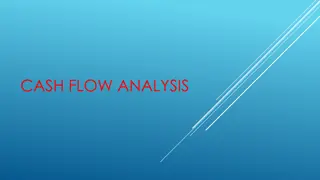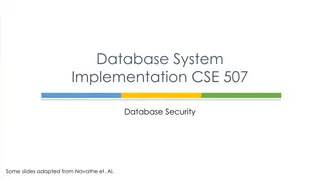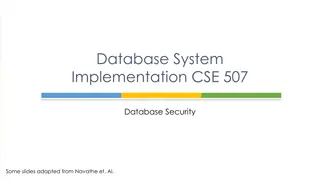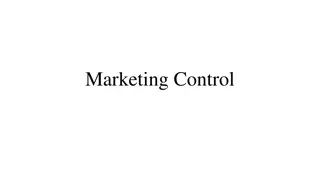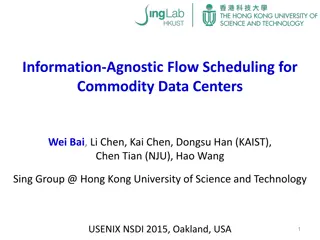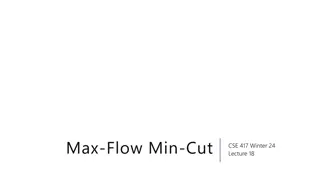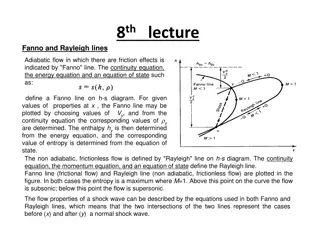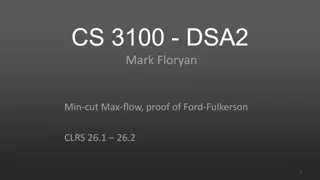
Understanding TCP Flow Control Mechanisms in Networking
Explore the concepts of Selective Repeat TCP, implications of ordered delivery, stream-oriented data transfer, and the significance of sequence numbers in TCP applications. Learn how TCP manages data transmission and the impact of packet reordering on application-level throughput.
Download Presentation

Please find below an Image/Link to download the presentation.
The content on the website is provided AS IS for your information and personal use only. It may not be sold, licensed, or shared on other websites without obtaining consent from the author. If you encounter any issues during the download, it is possible that the publisher has removed the file from their server.
You are allowed to download the files provided on this website for personal or commercial use, subject to the condition that they are used lawfully. All files are the property of their respective owners.
The content on the website is provided AS IS for your information and personal use only. It may not be sold, licensed, or shared on other websites without obtaining consent from the author.
E N D
Presentation Transcript
Flow Control Lecture 14 http://www.cs.rutgers.edu/~sn624/352-S22 Srinivas Narayana 1
Quick recap of concepts Selective repeat TCP: Connection-oriented Cumulative ACK ACK x Selective ACK ACK x SACK x1-x2,x3-x4,x5-x6 application process Precision of info: < Retransmissions Cumulative ACK Selective ACK recv() > TCP socket receiver buffers Complexity, bugs, < Ordering Reassembly App recv() TCP code from sender 1 2 4 3 receiver TCP interaction Data with sequence #
Implications of ordered delivery Packets cannot be delivered to the application if there is an in- order packet missing from the receiver s buffer The receiver can only buffer so much out-of-order data Subsequent out-of-order packets dropped It won t matter that those packets successfully arrive at the receiver from the sender over the network TCP application-level throughput will suffer if there is too much packet reordering in the network Data may have reached the receiver but won t be delivered to apps upon a recv() (...or may not even be buffered!)
Stream-Oriented Data Transfer
Sequence numbers in the apps stream Data written by application over time e.g., send() call 100 240 310 180 150 273 packet packet packet packet packet Increasing sequence #s TCP uses byte sequence numbers
Sequence numbers in the apps stream Data written by application over time e.g., send() call 100 240 310 180 150 273 packet packet packet packet packet Increasing sequence #s Packet boundaries aren t important for TCP software TCP is a stream-oriented protocol (We use SOCK_STREAM when creating sockets)
Sequence numbers in the apps stream Data written by application over time e.g., send() call 1st 2nd recv() 3rd 4th recv() A recv() call may return a part of a packet, a full packet, or multiple packets together. recv() recv() App does a recv()
= window size Proportional to throughput How much data to keep in flight? Stop and Wait RTT SEQ 0 RTT ACK SEQ 1 Pipelined Reliability RTO
We want to increase throughput, but Multiple locations for bottlenecks application process sender recv() Flow Control TCP socket receiver buffers What s the bottleneck? How to adapt how much data to keep in flight? TCP code Congestion Control from sender receiver
Socket buffers can become full application process Applications may read data slower than the sender is pushing data in Example: what if an app infrequently or never calls recv()? TCP socket receiver buffers There may be too much reordering or packet loss in the network What if the first few bytes of a window are lost or delayed? TCP code from sender Receivers can only buffer so much before dropping subsequent data TCP receiver
Goal: avoid drops due to buffer fill application process Have a TCP sender only send as much as the free buffer space available at the receiver. Amount of free buffer varies over time! TCP implements flow control Receiver s ACK contains the amount of data the sender can transmit without running out the receiver s socket buffer This number is called the advertised window size TCP socket receiver buffers TCP code from sender receiver protocol stack
TCP flow control Receiver Sender Receiver advertises to sender (in the ACK) how much free buffer is available 1 2 3 4 1 2 3 4 5
TCP flow control Receiver Sender Subsequently, the sender s sliding window cannot be larger than this value Restriction on new sequence numbers that can be transmitted == restriction on sending rate! 1 2 3 4 1 2 3 Window <= Advertised window 4 5 Sender s view: 0 3 1 0 4 1 2 5 7 6 Last cumulative ACK ed seq # Last transmitted seq #
TCP flow control Receiver Sender If receiver app is too slow reading data: receiver socket buffer fills up So, advertised window shrinks So, sender s window shrinks So, sender s sending rate reduces 1 2 3 4 1 2 3 Window <= Advertised window 4 5 Sender s view: 0 3 1 0 4 1 2 5 7 6 Last cumulative ACK ed seq # Last transmitted seq #
TCP flow control Receiver Sender Flow control matches the sender s write speed to the receiver s read speed. 1 2 3 4 1 2 3 Window <= Advertised window 4 5 Sender s view: 0 3 1 0 4 1 2 5 7 6 Last cumulative ACK ed seq # Last transmitted seq #
Sizing the receivers socket buffer Operating systems have a default receiver socket buffer size Listed among sysctl a | grep net.inet.tcp on MAC Listed among sysctl a | grep net.ipv4.tcp on Linux If socket buffer is too small, sender can t keep too many packets in flight lower throughput If socket buffer is too large, too much memory consumed per socket How big should the receiver socket buffer be?
Sizing the receivers socket buffer Case 1: Suppose the receiving app is reading data too slowly: no amount of receiver buffer can prevent low sender throughput if the connection is long-lived!
Sizing the receivers socket buffer Case 2: Suppose the receiving app reads sufficiently fast on average to match the sender s writing speed. Assume the sender has a window of size W. The receiver must use a buffer of size at least W. Why? Captures two cases: (1) When the first sequence #s in the window are dropped Selective repeat: data in window buffered until the ACKs of delivered data (within window) reach sender. Adv. win reduces sender s window (2) When the sender sends a burst of data of size W Receiver may not match the instantaneous rate of the sender
Summary of flow control Keep memory buffers available at the receiver whenever the sender transmits data Inform the sender on an on-going basis (each ACK) Function #1: match sender speed to receiver speed Function #2: reassemble data in order and hold for selective repeat Correct socket buffer sizing is important for TCP throughput
Info on (tuning) TCP stack parameters https://www.ibm.com/support/knowledgecenter/linuxonibm/liaag/ wkvm/wkvm_c_tune_tcpip.htm https://cloud.google.com/solutions/tcp-optimization-for-network- performance-in-gcp-and-hybrid







